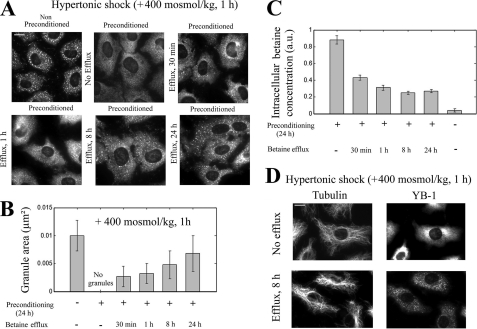FIGURE 7.
Betaine efflux in isotonic condition allows the recovery of SGs in preconditioned cells. A, NRK cells were preconditioned for 24 h in the presence of betaine (300 μm) with an extracellular osmolarity of 520 mosmol/kg for 24 h. Cells were then returned to isotonic condition s(320 mosmol/kg) in the absence of betaine for varying times as indicated before being exposed to hypertonic shock (+400 mosmol/kg) for 45 min. In contrast with preconditioned cells, cells returned to isotonic conditions displayed SGs. and their size increased with the time spent in isotonic conditions. Scale bar, 10 μm. B, statistical analysis of the SG areas obtained from A is shown. Results are the means ± S.D. Note that even after long efflux (24 h), SGs remains smaller than those of non preconditioned cells. C, shown is NMR quantification of the intracellular betaine content in preconditioned NRK cells after their return to isotonicity for indicated time. The results show that the rate of betaine efflux is rather rapid during the first hour but then considerably slows down with time. The betaine content is still significant after 24 h. Results are the means ± S.D. (1 a.u. corresponds to 72 fmol of betaine per NRK cell). D, betaine efflux also promotes MT bundling after hypertonic shock in preconditioned NRK cells. SGs and MTs were observed with anti-YB1 and anti-tubulin immunostaining. Scale bar, 10 μm.

